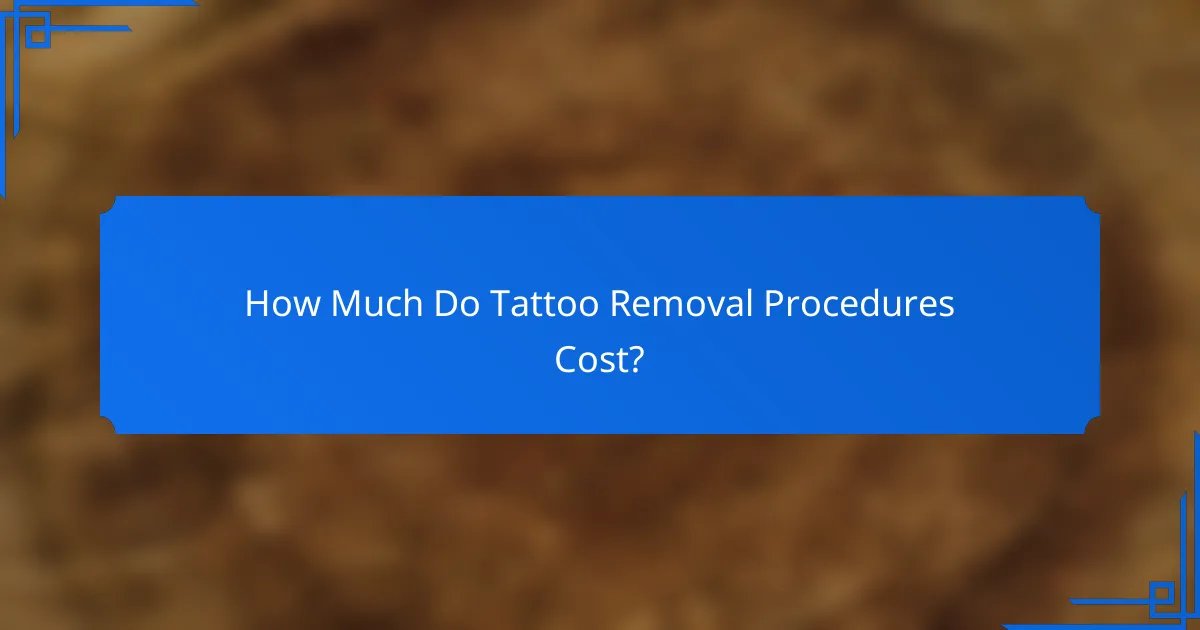Exploring tattoo removal options involves understanding various methods such as laser treatments, dermabrasion, and chemical peels, each with distinct effectiveness, safety profiles, and costs. The price of removal can vary widely based on factors like tattoo size and the chosen technique, often ranging from a few hundred to several thousand dollars. Prioritizing safety is essential, as each method carries its own risks that should be carefully considered before proceeding.

What Are the Best Tattoo Removal Options?
The best tattoo removal options include laser tattoo removal, dermabrasion, chemical peels, excision, and saline tattoo removal. Each method varies in effectiveness, safety, and cost, making it crucial to choose the one that best suits your needs and circumstances.
Laser Tattoo Removal
Laser tattoo removal is the most popular and effective method for eliminating tattoos. It works by using concentrated light beams to break down the ink particles in the skin, which are then absorbed by the body. Multiple sessions are typically required, and results can vary based on tattoo size, ink colors, and skin type.
Costs for laser removal can range from a few hundred to several thousand dollars, depending on the number of sessions needed. It’s essential to choose a qualified practitioner to minimize risks and ensure safety.
Dermabrasion
Dermabrasion involves mechanically sanding the skin to remove the outer layers where the tattoo ink resides. This method can be effective but may cause significant discomfort and requires a longer healing time compared to laser treatments.
Prices for dermabrasion can vary widely, often ranging from a few hundred to over a thousand dollars. Potential side effects include scarring and changes in skin texture, so it’s important to consult with a dermatologist before proceeding.
Chemical Peels
Chemical peels use acidic solutions to exfoliate the skin and fade tattoos over time. This method can be less invasive than dermabrasion but may require multiple applications to achieve desired results.
The cost of chemical peels typically falls between a few hundred to a thousand dollars, depending on the strength of the peel and the number of sessions. Skin sensitivity and potential for irritation are important considerations when choosing this option.
Excision
Excision involves surgically removing the tattooed skin and stitching the remaining skin together. This method is most suitable for small tattoos and provides immediate results.
Excision can be more expensive, often costing several hundred to a few thousand dollars, and it carries risks such as scarring. It’s crucial to discuss this option with a qualified surgeon to understand the implications and recovery process.
Saline Tattoo Removal
Saline tattoo removal uses a saline solution injected into the skin to draw out the ink. This method is considered less invasive than laser removal and can be effective for certain types of tattoos.
Costs for saline removal generally range from a few hundred to over a thousand dollars, depending on the tattoo’s size and complexity. While it can be a safer option for some, results may vary, and multiple sessions are often necessary.

How Much Do Tattoo Removal Procedures Cost?
The cost of tattoo removal procedures varies significantly based on the method used, the size and complexity of the tattoo, and the provider’s expertise. Generally, prices can range from a few hundred to several thousand dollars, depending on the chosen technique and the number of sessions required.
Average Cost of Laser Removal
Laser removal is one of the most common methods, with costs typically ranging from $200 to $500 per session. The total expense can accumulate as multiple sessions are often necessary, sometimes up to ten or more, depending on the tattoo’s size and ink depth. It’s crucial to consult with a certified professional to get an accurate estimate based on your specific tattoo.
Cost of Dermabrasion
Dermabrasion involves physically sanding the skin to remove the tattoo, with costs generally between $1,000 and $3,000 for the entire process. This method may require anesthesia and carries a longer recovery time compared to laser treatments. Consider the potential for scarring and the need for follow-up care when evaluating this option.
Pricing for Chemical Peels
Chemical peels use acidic solutions to break down the tattoo ink, with prices ranging from $500 to $1,500 per session. Similar to other methods, multiple treatments may be needed for optimal results. It’s essential to discuss skin type and potential side effects with a dermatologist before proceeding.
Excision Pricing
Excision involves surgically removing the tattooed skin, with costs typically between $1,500 and $4,000 depending on the tattoo’s size and location. This method is usually best for small tattoos and may result in scarring. Ensure you understand the surgical risks and recovery process before choosing this option.

What Are the Safety Considerations?
When considering tattoo removal, safety is paramount. Each method has unique risks and protocols that must be understood to minimize potential complications.
Risks of Laser Removal
Laser removal is generally safe but can lead to side effects such as skin irritation, blistering, or changes in pigmentation. The effectiveness varies based on tattoo ink colors and skin type, often requiring multiple sessions for optimal results.
Choosing a qualified practitioner is crucial. Ensure they use FDA-approved lasers and follow established safety guidelines to reduce the risk of complications.
Safety of Dermabrasion
Dermabrasion involves mechanically exfoliating the skin to remove the tattoo. While it can be effective, it carries risks such as scarring, infection, and prolonged healing times. Proper aftercare is essential to avoid complications.
It’s important to consult with a dermatologist who can assess your skin type and tattoo before proceeding, as not all tattoos are suitable for this method.
Potential Side Effects of Chemical Peels
Chemical peels use acids to break down tattoo ink, but they can cause redness, swelling, and peeling. The depth of the peel will influence the effectiveness and the likelihood of side effects, with deeper peels posing higher risks.
Consultation with a licensed professional is necessary to determine the appropriate strength of the peel and to ensure safety during the procedure.
Excision Safety Protocols
Excision involves surgically removing the tattooed skin, which can be effective for small tattoos. However, it requires careful surgical techniques to minimize scarring and ensure proper healing. Local anesthesia is typically used during the procedure.
Post-operative care is critical to prevent infection and promote healing. Follow your surgeon’s instructions closely and attend follow-up appointments to monitor recovery.

What Results Can You Expect?
Results from tattoo removal vary based on the method used, the tattoo’s characteristics, and individual skin types. Generally, you can expect significant fading or complete removal over multiple sessions, but some methods may leave scars or discoloration.
Laser Removal Effectiveness
Laser removal is one of the most popular and effective methods for tattoo removal. It works by targeting the ink particles with high-intensity light, breaking them down so the body can naturally eliminate them. Most people require several sessions, typically spaced 6-8 weeks apart, to achieve optimal results.
Effectiveness can vary based on ink color, tattoo age, and skin type. Darker inks, like black, tend to respond better than lighter colors. Expect about 50-90% fading after a series of treatments, but complete removal is not guaranteed.
Results from Dermabrasion
Dermabrasion involves mechanically sanding the skin to remove the outer layers where the tattoo ink resides. This method can lead to significant fading, but it may require multiple sessions and can be painful. Recovery time can vary from a few days to weeks, depending on the depth of the procedure.
While dermabrasion can be effective, it often leaves behind scars or changes in skin texture. It is crucial to consult a qualified professional to assess your skin type and tattoo before proceeding.
Outcomes of Chemical Peels
Chemical peels use acidic solutions to exfoliate the skin and fade tattoos gradually. This method is less invasive than dermabrasion but may require several applications to see noticeable results. The effectiveness can depend on the strength of the peel and the tattoo’s characteristics.
While chemical peels can be a good option for superficial tattoos, deeper inks may not respond as well. Skin irritation and discoloration are potential side effects, so it’s essential to follow post-treatment care instructions closely.
Excision Results
Excision involves surgically removing the tattooed skin, which can be effective for small tattoos. This method guarantees complete removal but will leave a scar, and the size of the scar will depend on the tattoo’s size and location. Recovery typically takes a few weeks.
Excision is often considered when other methods are not suitable or if the tattoo is small enough to be removed entirely. Consult with a dermatologist to evaluate if this option is right for you, especially regarding potential scarring and healing time.


